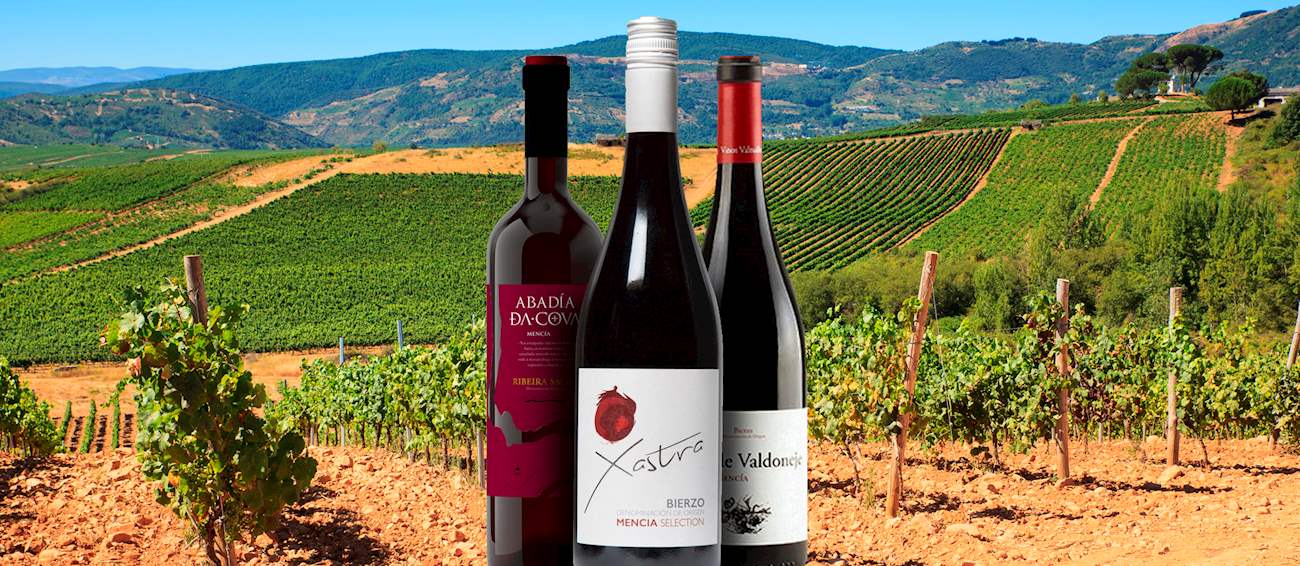Loureiro is a white grape variety mainly cultivated in Portugal. It is one of the most common grapes used in the production of the legendary Portuguese Vinho Verde. Some amount is also found in Spanish Galicia, where it is known as Loureira.
Although the grape is primarily used in Vinho Verde blends, there are some varietal examples. Loureiro wines are fresh, aromatic, low in alcohol, and high in acidity. The aromas are usually citrusy and floral, often reminiscent of lime, orange blossom, acacia, peach, and apples.
Mencía or Jaen is a grape whose origin is associated with the Iberian peninsula. In the past, it was believed that Mencía and Jaen are two separate varieties, but recent research has shown that they are genetically identical.
In Spain, the grape is mostly associated with the Bierzo appellation that is located in the province of León. While for most of its history, Mencía was used in the production of light, somewhat bland table wines, some winemakers have seen the potential to produce more concentrated and better quality varietals with a medium body and good natural acidity.
Bairrada is a small and narrow Portuguese appellation situated along the Atlantic Ocean. The region is best known for varietal red wines made from the local Baga grape. This high-yield grape usually produces powerful reds that age well and are typically high in tannins and acidity.
Although Baga is the undisputed king of the region, other Portuguese grapes (Touriga Nacional, Tinta Roriz) and some international varieties (Cabernet Sauvignon, Syrah, Merlot, Pinot Noir) are planted and mostly used in blends. Apart from the flagship red wines, Bairrada also includes small amounts of bottle-fermented sparkling wines and fresh, mineral whites usually made from Fernão Pires, Bical, and Arinto.
Late Bottled Vintage port is produced from a single year, and it is bottled after four to six years of age. Due to the slightly longer aging period, this style is more affordable than Vintage port, and it can be enjoyed immediately after it is released, though it can also be suitable for bottle aging.
Traditional styles are not filtered and tend to have more structure than brighter contemporary versions that are filtered before bottling. Although some purists argue that filtration strips away some of the essential features, this filtered LBV is the most common example.
Touriga Franca, also known as Touriga Francesa, is one of the most planted grape varieties in Portugal. It is used in the production of varietal wines, but it is mostly known as one of the quintessential grapes in red Douro blends and Port wines.
Although it is often cited as less prestigious than Touriga Nacional, this dark-skinned grape is able to produce dense wines with fruity and floral aromas that are reminiscent of red and dark berries and roses. The grape is native to Portugal, and though not much is known about its origin, it is believed that it is a cross between Touriga Nacional and another, unknown grape.
Castelão is a native Portuguese red-skinned grape that is mostly associated with sandy soils of Setúbal, but it is also grown in Tejo and Alentejo. It is one of the most commonly planted Portuguese grapes that is known under various synonyms and is used for both varietals and blends.
Although the character of these wines can slightly differ depending on soil and the region, the best expressions of Castelão will result in somewhat rustic, well-structured wines with bright acidity and firm tannins. With age, the tannins tend to become more mellow and softer.
Fernão Pires is a white grape native to Portugal that is mostly associated with the wine regions of Tejo (Ribatejo) and Bairrada (where it is known as Maria Gomes). The grape is used in either varietals or blends, and it is also suitable for the production of sparkling and dessert wines.
The best expressions of the grape produce highly aromatic dry wines that will usually display floral and fruity aromas reminiscent of roses and citrus fruit such as lime, lemon, orange, and mandarins. These wines are best enjoyed young, and they are best paired with fish, poultry, or pork.
TasteAtlas food rankings are based on the ratings of the TasteAtlas audience, with a series of mechanisms that recognize real users and that ignore bot, nationalist or local patriotic ratings, and give additional value to the ratings of users that the system recognizes as knowledgeable. For the “7 Worst Rated Portuguese Wines” list until March 26, 2025, 1,015 ratings were recorded, of which 700 were recognized by the system as legitimate. TasteAtlas Rankings should not be seen as the final global conclusion about food. Their purpose is to promote excellent local foods, instill pride in traditional dishes, and arouse curiosity about dishes you haven’t tried.





